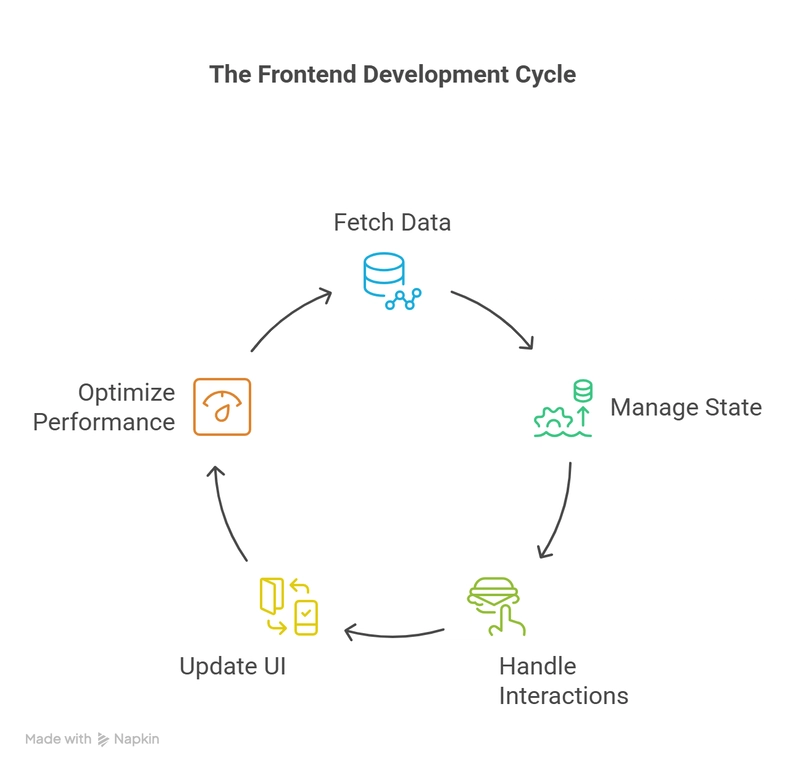When someone says "frontend," many still think it means styling buttons and aligning layouts. But frontend engineering is way more than UI.
At its core, it's about building systems that serve human experiences.
🔍 System Thinking in the Frontend
Frontend engineers make design decisions that ripple through the entire product.
We think in terms of:
- Data flow: Where does the data come from? Who owns it? How is it updated?
- State models: What does the UI look like in each state? Loading, error, empty, success?
- Component architecture: How do we break the UI into reusable, testable pieces?
- User experience flow: How does a user's action change the application state or behavior?
- Accessibility and edge cases: Can everyone, regardless of ability or device, use the product?
This is system thinking — seeing the frontend not as isolated screens but as part of a living, breathing system that reacts, updates, and scales.
🧠 UI is Static. Frontend is Dynamic.
Let’s break it down:
| UI (Visual Layer) | Frontend Engineering |
|---|---|
| Buttons and colors | State handling (e.g., Redux) |
| Layout and spacing | API integration |
| Typography | Component lifecycle |
| Icons and visuals | Conditional rendering |
| Style guides | Form validation & error flows |
🧩 A Real-World Example
Imagine building a simple to-do app.
Visually, it’s just:
- An input field
- A list
- Some checkboxes
But behind the scenes, you’re designing:
- A state model: What happens when a task is marked done? Deleted? Filtered?
- A component structure: List → Item → Checkbox → Actions
- Data synchronization: Does this update locally? Remotely? In both?
- Error handling: What if the server fails?
- Usability: Can a user with screen reader interact with it?
This is system-level thinking — applied to the browser.
🔄 It’s About Building Products That Think
Frontend engineering today is about:
- Designing human-centered systems
- Balancing speed and structure
- Bridging design with logic
- Making products that scale and feel good to use
👨💻 Final Thoughts
Frontend isn't fluff. It's not just CSS and colors.
It’s the glue between humans and machines.
Whether you’re designing a dashboard, a mobile app, or an interactive form — you’re thinking in systems. And that’s where the real challenge (and joy) lies.
💬 Do you see frontend as a system too? Or just presentation? Let’s talk in the comments.




Top comments (9)
You are absolutely right, but there's also a clear difference between the terms frontend and UX, they are definitely not the same. Currently I'm developing a monitoring, changelogs and incident management system. Writing code for the frontend of that very much feels like backend.
The frontend is a whole different ball game. Back when I worked at my previous company, our PM wanted a checkbox on a screen. She set the due date for this task to the same day and estimated it to take 2 hours (she said she gave me some extra time). But guess what? When we started implementing it, we found out that the checkbox is conditional. We need to check some privileges to show that tiny checkbox, and for those privileges, we need to verify some more access because those privileges are conditional too. And to top it all off, when that checkbox is checked, a notification is sent to the C-Level management dashboard. So, it should be on time when the management is on their PCs and they want to see it. In short, we also need to make that checkbox hidden until C-Level managers are not on their seats so that the action can't be unattended at their end.
PS: This simple checkbox took 2 consecutive days (14 hrs), data models were modified, and new states and data flow were defined.
Well explained.
What managment said in story, Just add a single check-box. :D
It is one of the many reasons there are distinct job descriptions and skill sets for "UX/UI designers" and "frontend engineers" out there.
Being able to translate UI to code (be it Figma, HTML or whatever) doesn't makes you automatically a full fledged frontend engineer.
I totally agree with your point.
In a professional context, I think it's really important to differentiate between UI, UX, and frontend. They're closely related, but not interchangeable.
As frontend developers, we often work at the intersection of design and logic — implementing UI elements is just one part of the job. There's also state management, performance optimization, accessibility, responsiveness, integration with backend services, and so much more.
Great reminder that frontend is a broad and complex field that goes well beyond what the user sees on screen. Thanks for sharing this!
Agreed 💯
Absolutely agree!
I have never thought frontend that way described by de article. Very good explanation.